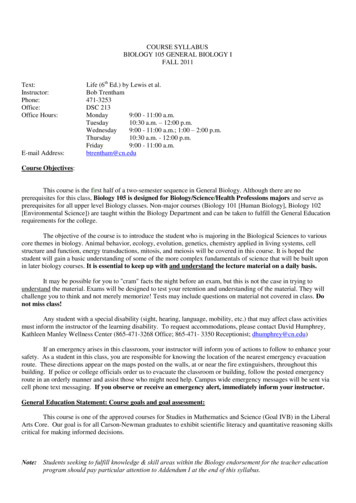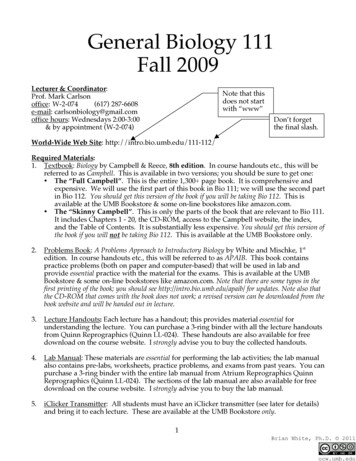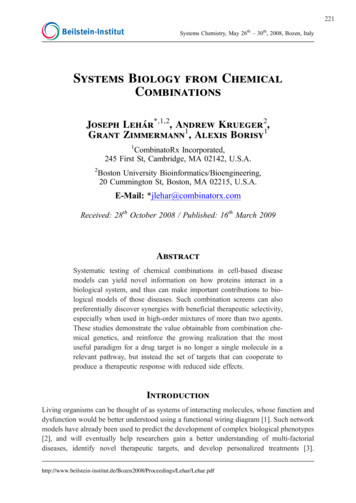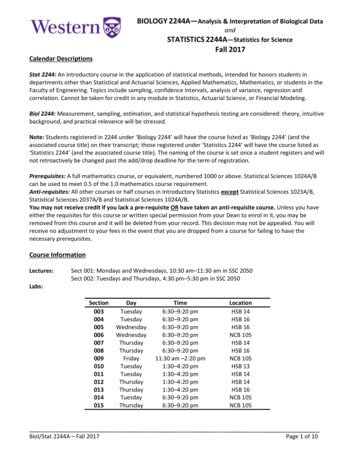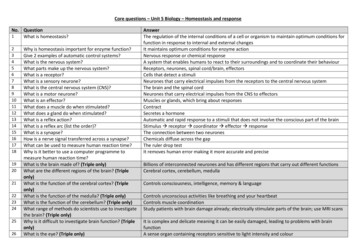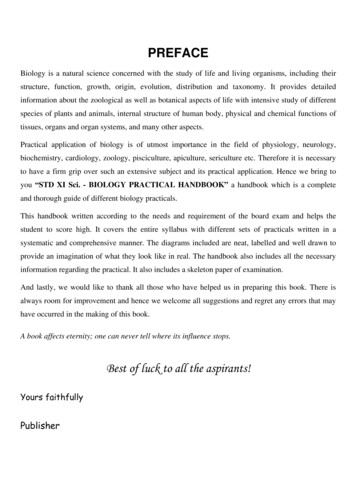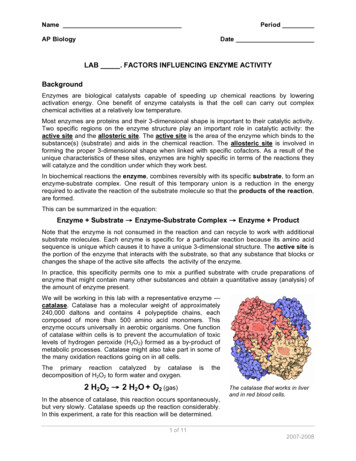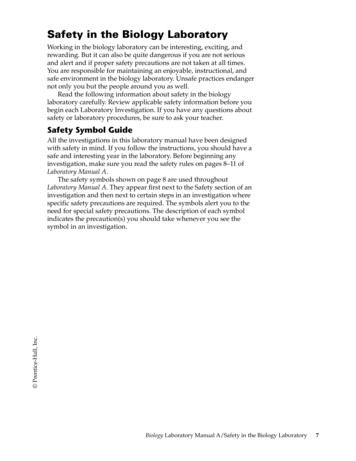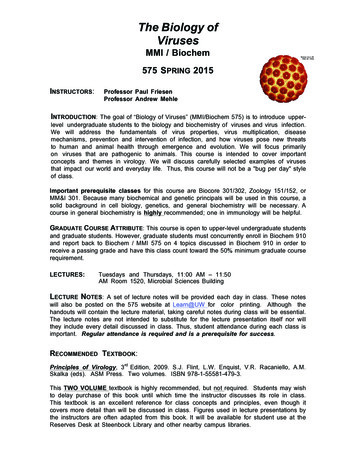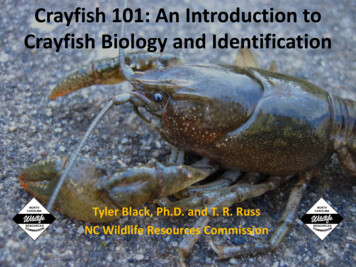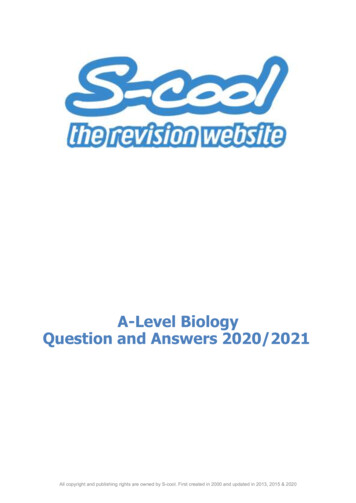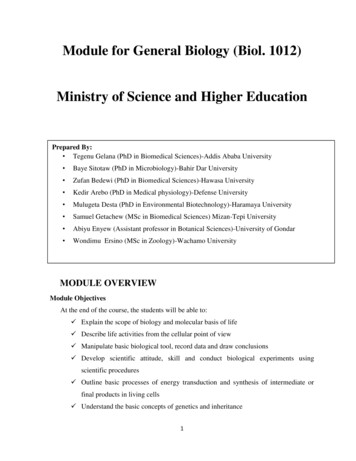
Transcription
Module for General Biology (Biol. 1012)Ministry of Science and Higher EducationPrepared By: Tegenu Gelana (PhD in Biomedical Sciences)-Addis Ababa UniversityNovember, 2019 Baye Sitotaw (PhD in Microbiology)-Bahir Dar University Zufan Bedewi (PhD in Biomedical Sciences)-Hawasa University Kedir Arebo (PhD in Medical physiology)-Defense University Mulugeta Desta (PhD in EnvironmentalUniversityAddis AbabaBiotechnology)-HaramayaEthiopia Samuel Getachew (MSc in Biomedical Sciences) Mizan-Tepi University Abiyu Enyew (Assistant professor in Botanical Sciences)-University of Gondar Wondimu Ersino (MSc in Zoology)-Wachamo UniversityNovember, 2019GCMODULE OVERVIEWModule ObjectivesAt the end of the course, the students will be able to: Explain the scope of biology and molecular basis of life Describe life activities from the cellular point of view Manipulate basic biological tool, record data and draw conclusions Develop scientific attitude, skill and conduct biological experiments usingscientific procedures Outline basic processes of energy transduction and synthesis of intermediate orfinal products in living cells Understand the basic concepts of genetics and inheritance1
Understand the concepts of infection and immunity Classify organisms based on their cellular organization and complexity Explain components, processes and interrelationships within a given ecosystem Know the general features of invertebrate and vertebrate animals Appreciate the practical uses ofbiological knowledge and its application in thewider society2
Acknowledgements3
Chapter One1. IntroductionDear learner! Welcome to this module which deals about the course, General Biology (Biol.1012). This module chapter is primarily intended for natural science students to familiarize withbasic concepts of biological science, the nature and origin of life, scientific methods and thesubject matter of biology. I hope you will find it interesting!Learning Objectives: After completing this chapter you will be expected to: define the term biology explain scientific methods know the origin and the nature of life1.1. The meaning and scope of biologySelf test:1. Do you know the meaning and the scope of Biology? Discuss it3. Explain the origin and the nature of life4. What are the branches of biology ?Biological Sciences is the study of life and living organisms. It is also called as “Biology”.The Greek word „bio‟ means life and „logos‟ means study of. In the late 1700s Pierre-Antoinede Monet and Jean-Baptiste de Lamarck coined the term biology. Earlier study of livingthings was restricted to the pure Science like Botany and Zoology that together comprise theBiology. But as the time passed new branches evolved. New technologies developed in puresubjects as well as in applied fields, which gave rise to a very broad concept of science calledBiological Sciences. Biological Sciences is an extensive study covering the minute workingsof chemical substances inside living cells to the broad scale concepts of ecosystems andglobal environmental changes.It is also concerned with the physical characteristics and behaviors of organisms living todayand long ago. How they came into existence and what relation they possess with each otherand their environments? Intimate study of details of the human brain, the composition of ourgenes, and even the functioning of our reproductive system are dealt in Biological sciences.4
Therefore, Biology is the science of Living Things. That is why Biology is sometimes knownas Life Science.The life sciences can be defined as “a systematic study of living beings or study of nature”.Teaching of life Science basically deals with providing information about the latestdevelopments in the field of Biological sciences all over the world.1.2. The origin and nature of lifeSelf test:1. Explain the origin and the nature of life4. What are the Scientific Methods?One of the biggest and most important of emergent phenomena is that of the origin oremergence of life. The mystery of life's origin is still a big debating issue in science. Thequestion “what is life?” is so hard to answer; we really want to know much more than what itis, we want to know why it is, “we are really asking, in physical terms, why a specific materialsystem is an organism and not something else”. To answer this why question we need tounderstand how life might have originated. There are a number of theories about the origin oflife. The next few sections give emphasis on these different theories about the origin of life.The evolution of life on earth has involved the following sequence of events. The first livingthings to appear were the simplest creatures, single-celled organisms. From these came morecomplex, multi-cellular organisms. Becoming more complex meant more than just an increasein cell number but more cells showed cellular specialization, where certain cells within themulti-cellular organism carried out specific tasks. Millions, even billions of years of changesof organisms led to the living things we now call plants and animals.Since this basic sequence of events is in accord with that agreed upon by most geologists,paleontologists, biologists, and even theologians, one might conclude that Moses, Aristotle,and Darwin were all keen observers and naturalists who were able to logically assess the mostprobable creation story. Scientists generally concur that the time from the formation of oursolar system until now has been on the order of some 4.5 billion years. Those who believe theworld as we know it was created in six days are often called creationists. Their method of5
inquiry is based on the belief that the Bible is to be accepted as a completely accurateaccounting of all about which it speaks. Scientists, on the other hand, utilize what they call thescientific method, which allows them to test hypotheses and theories and to develop conceptsand ideas.Summary of Theories on Origin of lifeSeveral attempts have been made from time to time to explain the origin of life on earth. As aresult, there are several theories which offer their own explanation on the possible mechanismof origin of life. Following are some of them:1. Theory of Special Creation: according to this theory, all the different forms of life thatoccur today on planet earth have been created by God, the almighty.Theory of Spontaneous Generation: this theory assumed that living organisms could arisesuddenly and spontaneously from any kind of non-living matter. One of the firm believers inspontaneous generation was Aristotle, the Greek philosopher (384-322 BC).2.Theory of Catastrophism: It is simply a modification of the theory of Special Creation. Itstates that there have been several creations of life by God, each preceded by a catastropheresulting from some kind of geological disturbance. According to this theory, since eachcatastrophe completely destroyed the existing life, each new creation consisted of life formdifferent from that of previous ones.3. Cosmozoic Theory (Theory of Panspermia): according to this theory, life has reached thisplanet Earth from other heavenly bodies such as meteorites, in the form of highly resistancespores of some organisms. This idea was proposed by Richter in 1865 and supported byArrhenius (1908) and other contemporary scientists. The theory did not gain any support. Thistheory lacks evidence, hence it was discarded.4. Theory of Chemical Evolution: this theory is also known as Materialistic Theory orPhysico-chemical Theory. According this theory, Origin of life on earth is the result of a slowand gradual process of chemical evolution that probably occurred about 3.8 billion years ago.This theory was proposed independently by two scientists - A.I.Oparin, a Russian scientist in1923 and J.B.S Haldane, an English scientist, in 1928.6
Nature and characteristics of lifeLife is defined as a "condition" that distinguishes animals and plants from inorganic materialsand dead organisms. Life is comprised of processes and is a maintained state. The most sophisticated form of life is man as a result of this we focuses upon thenature of the life and death of man.Man demonstrates three lives or aspects of life: Life of the body (physical), life of the mindand life of the spirit. Physical life is basic existence Mind contributes effectiveness and scope Spiritual entity contributes maximum living.Physiology: The existence of life physical is demonstrated by the presence of functions.Living tissues and organisms exhibit:Irritability: the ability to be excited or detect stimuli and to respond theretoGrowth and reproduction: this consists of the power of multiplication and duplication,regeneration and differentiationAdaptability: permitting both change and maintenance of balances (homeostasis)Finally and most characteristic of all is Metabolism: the transformation of energy and theuse of materials. These properties, however, can be retained for a while by tissues afterdeath of the organism so there is another mystery of life which we understand only in part.Excretion :excretion and osmoregulation regulation are two important homeostaticprocesses occurring in living cells, helping them to maintain a constant internalenvironment, or steady state. Excretion is the removal from the cell of waste products ofmetabolism. In plant cells the major excretory products are oxygen from photosynthesisand carbon dioxide from cell respiration.7
1.3. Scientific methodsSelf test:1. Write dawn the main steps of the scientific methods in sequence?2. You observe that a room appears dark, and you wonder why the room is dark? In anattempt to find explanations to this curiosity, what are the possible hypotheses thatcome in your mind to discover the truth?3. What are the major common properties of living things?The scientific method is a process for experimentation that is used to exploreobservations and answer questions. It is an empirical method of acquiring knowledge. It isalso the technique used in the construction and testing of a scientific hypothesis.The scientific method has five basic steps, plus one feedback step: Make an observation. Ask a question. Form a hypothesis, or testable explanation. Make a prediction based on the hypothesis. Test the prediction. Iterate: use the results to make new hypotheses or predictions.Observation - Quantitative and qualitative measurements of the world.Inference - Deriving new knowledge based upon old knowledge.Hypotheses –A suggested explanation.Rejected Hypothesis - An explanation that has been ruled out through experimentation.Accepted Hypothesis - An explanation that has not been ruled out through excessiveexperimentation and makes verifiable predictions that are true.Experiment - A test that is used to rule out a hypothesis or validate something already known.Scientific Method - The process of scientific investigation.Theory - A widely accepted hypothesis that stands the test of time. Often tested, and usuallynever rejected.The scientific method is based primarily on the testing of hypotheses by experimentation. Thisinvolves a control, or subject that does not undergo the process in question. A scientist will8
also seek to limit variables to one or another very small number, single or minimum numberof variables. The procedure is to form a hypothesis or prediction about what you believe orexpect to see and then do everything you can to violate that, or falsify the hypotheses.Although this may seem unintuitive, the process serves to establish more firmly what is andwhat is not true.Summary of the scientific methodStep 1: Observe behavior or other phenomenaStep 2: Form a tentative answer or explanation (a hypothesis (guess a reason)Step 3: Use your hypothesis to generate a testable predictionStep 4: Make systematic, planned observations (data collection)Step 5: Results and Discussion , Use the observations to evaluate (support, refute, orrefine) the original hypothesisStep 6: ConclusionStep 7: RecommendationChapter review questions1. List dawn all the steps used in scientific methods2. Propose a hypothesis in an attempt to find explanations for this curiosity3. Explain the differences between control and variable group4. List down the characteristics common to all living things5. What is a controlled experiment? Why is it essential to have a control group inscientific experiment?9
Chapter Two2. Biological MoleculesBiological molecules are often referred to as the molecules of life (bio-molecules) that arebasically found in a living cell and categorized as organic and inorganic molecules in general.Each member of the groups is vital for every single organism on Earth. The organicbiomolecules are proteins, carbohydrates, lipids and nucleic acids. Without any of these fourmolecules, a cell and organism would not be able to live.They are important eitherstructurally or functionally for cells and, in most cases, they are important in both ways. themost commonly known inorganic molecules are water and minerals, which are still importantfor the normal functioning of the cell.Learning Objectives: After completing this chapter you will be expected to: define the term biomolecules describe list of organic and inorganic molecules and their biological importance identify the basic structures of biomolecules explain the precursors of each macromolecules with their respective polymerizationprocess state the physical and chemical nature of water and their relevance to the existenceof life2.1. CarbohydratesSelf test:1. What are the elemental compositions of carbohydrates?2. Why cells rely on carbohydrates as a major source of energy compared to otherbiomolecules?3. What are the additional importance's of carbohydrates besides their role as energy source?A carbohydrate molecule is made of atoms of carbon, hydrogen and oxygen. They are animportant source of energy and they also provide structural support for cells and help withcommunication between cells (cell-cell recognition). They are found in the form of either asugar or many sugars linked together, called saccharides. Based on the number sugar unitsthey contain, they are categorized into three, as follows.10
A single sugar molecule containing carbohydrate is known as a monosaccharides,while two and many having are regarded as disaccharides and polysaccharides,respectively. Each of the sugar molecules are bonded together through the glycosidic linkage/s. Thethree different types of carbohydrates are all important for different reasons Carbohydrates are polyhydroxy aldehydes or ketones, or substances that yield thesecompounds on hydrolysis. Example: Glucose is aldehyde and fructose is Ketone.Monosaccharides - simple sugars with multiple OH groups. Based on number of carbons (3, 4,5, 6), a monosaccharide is a triose, tetrose, pentose or hexose.Disaccharides - 2 monosaccharides covalently linkedOligosaccharides - a few monosaccharides covalently linked.Polysaccharides - polymers consisting of chains of monosaccharide or disaccharideFig: 2.1. Structure of monosaccharides (glucose and fructose)6 CH2OH6 CH2OHH4OH5OHOHH3H145OHOHHO2OHHH3maltoseFig: 2.2. Structure of maltose (disaccharides)11HH12OHOH
MonosaccharidesMonosaccharides containing the aldehyde group are classified as aldoses, and those with aketone group are classified as ketoses. Aldoses are reducing sugars; ketoses are non-reducingsugars. This is important in understanding the reaction of sugars with Benedict's reagent.However, in water pentoses and hexoses exist mainly in the cyclic form, and it is in this formthat they combine to form larger saccharide molecules.GlucoseGlucose is the most important carbohydrate fuel in human cells. Its concentration in the bloodis about 1 gdm-3. The small size and solubility in water of glucose molecules allows them topass through the cell membrane into the cell. Energy is released when the molecules aremetabolized.Two glucose molecules react to form the dissacharide maltose. Starch and cellulose arepolysaccharides made up of glucose units.GalactoseGalactose molecules look very similar to glucose molecules. They can also exist in α and βforms. Galactose reacts with glucose to make the dissacharide lactose. However, glucose andgalactose cannot be easily converted into one another. Galactose cannot play the same part inrespiration as glucose. This comparison of glucose and galactose shows why the precisearrangement of atoms in a molecule (shown by the displayed formula) is so important.FructoseFructose, glucose and galactose are all hexoses. However, whereas glucose and galactose arealdoses (reducing sugars), fructose is a ketose (a non-reducing sugar). It also has a five-atomring rather than a six-atom ring. Fructose reacts with glucose to make the dissacharidesucrose.Ribose and deoxyriboseRibose and deoxyribose are pentoses. The ribose unit forms part of a nucleotide of RNA. Thedeoxyribose unit forms part of the nucleotide of DNA.12
DisaccharidesMonosaccharides are rare in nature. Most sugars found in nature are disaccharides. Theseform when two monosaccharides react. Disaccharides are soluble in water, but they are toobig to pass through the cell membrane by diffusion. They are broken down in the smallintestine during digestion to give the smaller monosaccharides that pass into the blood andthrough cell membranes into cells.This is a hydrolysis reaction and is the reverse of a condensation reaction and it releasesenergy.A condensation reaction takes place by releasing water. This process requires energy. Aglycosidic bond forms and holds the two monosaccharide units together. The three mostimportant disaccharides are sucrose, lactose and maltose. They are formed from the a formsof the appropriate monosaccharides. Sucrose is a non-reducing sugar. Lactose and maltose arereducing sugars.Monosaccharides are used very quickly by cells. However, a cell may not need all the energyimmediately and it may need to store it. Monosaccharides are converted into disaccharides inthe cell by condensation reactions. Further condensation reactions result in the formation ofpolysaccharides. These are giant molecules which, importantly, are too big to escape from thecell. These are broken down by hydrolysis into monosaccharides when energy is needed bythe cell.PolysaccharidesMonosaccharides can undergo a series of condensation reactions, adding one unit afteranother to the chain until very large molecules (polysaccharides) are formed. This is calledcondensation polymerisation, and the building blocks are called monomers. The propertiesof a polysaccharide molecule depend on:13
Its length (though they are usually very long) The extent of any branching (addition of units to the side of the chain rather than oneof its ends) Any folding which results in a more compact molecule Whether the chain is 'straight' or 'coiled'StarchStarch is often produced in plants as a way of storing energy. It exists in two forms: amyloseand amylopectin. Both are made from α-glucose. Amylose is an unbranched polymer of αglucose. The molecules coil into a helical structure. It forms a colloidal suspension in hotwater. Amylopectin is a branched polymer of α-glucose. It is completely insoluble in water.GlycogenGlycogen is amylopectin with very short distances between the branching side-chains. Starchfrom plants is hydrolysed in the body to produce glucose. Glucose passes into the cell and isused in metabolism. Inside the cell, glucose can be polymerised to make glycogen which actsas a carbohydrate energy store.CelluloseCellulose is a third polymer made from glucose. But this time it's made from β-glucosemolecules and the polymer molecules are 'straight'. Cellulose serves a very different purposein nature to starch and glycogen. It makes up the cell walls in plant cells. These are muchtougher than cell membranes. This toughness is due to the arrangement of glucose units in thepolymer chain and the hydrogen-bonding between neighboring chains. Cellulose is nothydrolysed easily and, therefore, cannot be digested so it is not a source of energy for humans.The stomachs of Herbivores contain a specific enzyme called cellulase which enables them todigest cellulose.Summary of carbohydrates The most abundant organic molecules in nature Are polyhydroxy aldehydes or ketones, or substances that yield these compounds on14
hydrolysis Provide a significant fraction of the energy in the diet of most organisms Important source of energy for cells Can act as a storage form of energy Can be structural components of many organisms Can be cell-membrane components mediating intercellular communication Can be cell-surface antigens Can be part of the body‟s extracellular ground substance Can be associated with proteins and lipids Part of RNA, DNA, and several coenzymes (NAD , NADP , FAD, CoA)2.2. LipidsSelf Test:1. What are lipids?2. What is the difference between saturated and unsaturated?3. What are the physiological and structural roles of lipids for life forms?Lipids are a highly variable group of molecules that include fats, oils, waxes and somesteroids. They are esters of fatty acids and alcohol (glycerol or chains of alcohols). Fatty acidsare made mostly from chains of carbon and hydrogen and they bond to a range of other typesof atoms to form many different lipids. The primary function of lipids is to store energy.A lipid called a triglyceride is a fat if it is solid at room temperature and an oil if it is liquid atroom temperature. In addition, triglycerides are stored in the fat cells , also called adipocytesor lipocytes, and are responsible in storing fats and lipids which will facilitate energy store inanimal‟s body. Fat cells are categorized in white fat cells and brown fat cells. The different ismade from their ways of storing lipids. White fat cells store one large lipid drop while brownfat cells store smaller and multiple droplets of lipids spreading in the whole body of the cell.Various types of lipids occur in the human body, namely 1) triacylglycerol, 2) cholesterol, and3) polar lipids, which include phospholipids, glycolipids and sphingolipids. Plant leaves arecoated with lipids called waxes to prevent water loss, and the honeycomb in a beehive is madeof beeswax.15
The basic structure of a lipid includes fatty acid tails as shown in Figure 2.3. Each tail is achain of carbon atoms bonded to hydrogen and other carbon atoms by single or double bonds.Lipids that have tail chains with only single bonds between the carbon atoms are calledsaturated fats because no more hydrogens can bond to the tail. Lipids that have at least onedouble bond between carbon atoms in the tail chain can accommodate at least one morehydrogen and are called unsaturated fats. Fats with more than one double bond in the tail arecalled polyunsaturated fats.Properties of lipids Insoluble in water Longer chains More hydrophobic, less soluble Double bonds increase solubility Melting points: Depend on chain length and saturation Double bonds lead acyl chain disorder and low melting temperatures Unsaturated fatty acids are solid at room temperature.Importance of lipids As the main component of cell membranes (phospholipids) Insulation of heat and water, Storing energy, protection and cellular communication.Activity1. What are the elemental compositions of lipids?2. Why lipids act as major source of energy?3. What are the major classes of lipids?4. Jot down the importance of cholesterol?2.3. ProteinsSelf Test:1. Comment on the following statements (answer by saying true or false for each statementand then elaborate)a) all proteins are enzymes16
b) enzymes initiate a chemical reactionc) chemical reactions cannot take place in the body without enzymes2. What are the elemental composition of proteins?3. What are the physiological and structural roles of proteins?4.Compare protein with nucleic acid5. How is the primary structure of a protein determined?A protein is a compound made of small carbon compounds called amino acids. Amino acidsare small compounds that are made of carbon, nitrogen, oxygen, hydrogen, and sometimessulfur. All amino acids share the same general structure.Amino acids have a central carbon atom like the one shown in Fig. 2.3. Recall that carbon canform four covalent bonds. One of those bonds is with hydrogen. The other three bonds arewith an amino group (–NH2), a carboxyl group (–COOH), and a variable group (–R). Thevariable group makes each amino acid different. There are 20 different variable groups, andproteins are made of different combinations of all 20 different amino acids. Several covalentbonds called peptide bonds join amino acids together to form proteins, which is also shown inFig. 2.3. A peptide forms between the amino group of one amino acid and the carboxyl groupof another.Fig: 2.3. Basic structure of amino acidBased on the variable groups contained in the different amino acids, proteins can have up tofour levels of structure. The number of amino acids in a chain and the order in which theamino acids are joined define the protein‟s primary structure. After an amino acid chain isformed, it folds into a unique three-dimensional shape, which is the protein‟s secondarystructure. A protein might contain many helices, pleats, and folds. The tertiary structure ofmany proteins is globular, such as the hemoglobin protein, but some proteins form long fibers.Some proteins form a fourth level of structure by combining with other proteins.17
Fig: 2.4. Peptide bondProteins make up about 15 percent of your total body mass and are involved in nearly everyfunction of your body. For example, your muscles, skin, and hair all are made of proteins.Your cells contain about 10,000 different proteins that provide structural support, transportsubstances inside the cell and between cells, communicate signals within the cell and betweencells, speed up chemical reactions, and control cell growth.2.4. Nucleic acidsSelf Test:1. What is the role of nucleic acid?2. What are the molecular composition of nucleotides?3. Describe briefly the differences between DNA & RNA?Nucleic acids are complex macromolecules that store and transmit genetic information.Nucleic acids are made of smaller repeating subunits called nucleotides. Nucleotides arecomposed of carbon, nitrogen, oxygen, phosphorus, and hydrogen atoms arranged as shown inFig. 2.5. There are six major nucleotides, all of which have three units a phosphate, anitrogenous base, and a ribose sugar.18
Fig: 2.5. Basic structure of nucleotideThere are two types of nucleic acids in living organisms: deoxyribonucleic acid (DNA) andribonucleic acid (RNA). In nucleic acids such as DNA and RNA, the sugar of one nucleotidebonds to the phosphate of another nucleotide. There are five different bases found innucleotide subunits that make up DNA and RNA, Adenine, Cytosine, Guanine, Thymine andUracil. Each of these nitrogenous base that sticks out from the chain is available for hydrogenbonding with other bases in other nucleic acids.Fig: 2.6. Nitrogenous bases19
A nucleotide with three phosphate groups is adenosine triphosphate (ATP). ATP is astorehouse of chemical energy that can be used by cells in a variety of reactions. It releasesenergy when the bond between the second and third phosphate group is broken.2.5. VitaminsSelf Test:1. What are vitamins?2. What are the roles of vitamins in maintaining homeostasis.?3. What are the water soluble and fat soluble vitamins?Vitamins are organic compounds that are needed in small amounts for metabolic activities.Many vitamins help enzymes function well. Vitamin D is made by cells in your skin. Some Bvitamins and vitamin K are produced by bacteria living in the large intestine. Sufficientquantities of most vitamins cannot be made by the body, but a well-balanced diet can providethe vitamins that are needed. Some vitamins that are fat-soluble can be stored in smallquantities in the liver and fatty tissues of the body. Other vitamins are water-soluble andcannot be stored in the body. Foods providing an adequate level of these vitamins should beincluded in a person‟s diet on a regular basis.2.6 WaterSelf Test:What are the physical and chemical properties of water, and their roles in maintaininghomeostasis.?Water molecules are formed by covalent bonds that link two hydrogen (H) atoms to one oxygen(O) atom, and each water molecule has the same structure. It is one of the most plentiful andessential of compounds, which is a tasteless and odorless, existing in gaseous, liquid, and solidstates. It has the important ability to dissolve and as a media for transportation of many othersubstances. In reality, the versatility of water as a solvent is essential to living organisms, as well.Water molecules have an unequal distribution of charges and are called polar molecules, meaningthat they have oppositely charged regions.20
Activity (Think Scientifically)1.What would have happened to the living things if the color of water was black or red?2.Even if water exists on other planets but it couldn't support life but what is the mysterybehind this for the existence of life on earth?2.7. MineralsSelf Test:1. What are minerals?2. What are the roles of minerals in maintaining homeostasis.?Minerals are inorganic compounds used by the body as building material, and they areinvolved with metabolic functions. For example, the mineral iron is needed to makehemoglobin and it binds to hemoglobin in red blood cells and is delivered to body cells asblood circulates in the body. Calcium, and other minerals, is an important component of bonesand is involved with muscle and nerve functions and they serve as cofactors for enzymes.Magnesium is an important component of the green pigment, chlorophyll, involved inphotosynthesis.Activity1. Explain why raw edible oil is added on dishes of raw vegetables before consumption?Summary of unit two Carbon compounds are the basic building block
4 Chapter One 1. Introduction Dear learner! Welcome to this module which deals about the course, General Biology (Biol. 1012). This module chapter is primarily intended for natural science students to familiarize with basic concepts of biological science, the nature and origin of li
